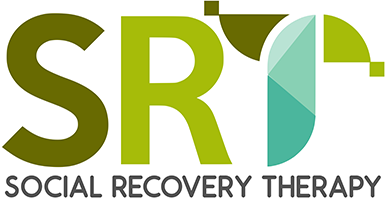SRT Social Anxiety as a barrier to social recovery
SRT Social Anxiety is typically one of the mental health barriers found in the maintenance of social disability. It may present itself as per model (e.g. Clark and Wells, 1995) or associated with mental health stigma, in which people may see themselves and perceive themselves as being seen as different due to comorbid mental health difficulties.
SRT Social Anxiety can contribute to individuals avoiding structured activity due to fear of embarrassing oneself or others or receiving negative evaluations from other people. Long-standing avoidance of social situations may also lead to problems developing and practicing social skills, which further complicates perceived and actual ability to engage in social interactions across different settings.
Social anxiety and SRT
Careful assessment focusing on avoidance and safety behaviours, as well as anticipatory and anxiety and ruminative processes following the social situations is crucial. It’s important to look at how the person perceives himself or herself in the social situation, and particularly if they have an image of themselves. Analysing a recent social situation in detail is ideal, however, due to the nature of their difficulties, many of those experiencing social disability will not have been in social situations recently. In these cases, explorative behavioural experiments could be conducted, with both therapist and the person observing what happens.
As with the other barriers, therapists should focus on how social anxiety is interfering with social recovery. A careful shared formulation should precede intervention, yet formulation should be revisited and informed by information gained during further cognitive, behavioural and multi-systemic work.
Specific SRT techniques involved in working with social anxiety as a barrier to social recovery include:
1. Maximise use of behavioural experiments –
- Interventions should focus largely on behavioural experiments followed by careful discussions and cognitive restructuring.
- These behavioural experiments typically involve entering avoided social situations, whilst dropping safety behaviours.
- These experiments allow the person to test out beliefs and develop different perspectives on their problems.
2. Experiment with attentional focus and acting ‘as if’ –
- Behavioural experiments involving internal versus external focus of attention and acting ‘as if’ are also extremely valuable.
- These experiments inspired by a sense of purpose and meaning, and so linked to the person’s values, interests and recovery goals.
3. Emphasise positive movement towards goals –
- The key is persistence, optimism and hope, and keeping in mind that each step, no matter how small, is a step towards personal social recovery.
Additional Resources
Butler (2007) Overcoming social anxiety and shyness self-help course: Part two. LINK
Butler & Hackmann (2004) Social anxiety. In J. Bennett-Levy, G. Butler, M. Fennell, A. Hackmann, M. Mueller & D. Westbrook (Eds.), Oxford guide to behavioural experiments in cognitive therapy. Oxford: Oxford University Press. READ MORE
Stott et al. (2010). Oxford guide to metaphors in CBT: Building cognitive bridges. Oxford: Oxford University Press. READ MORE

